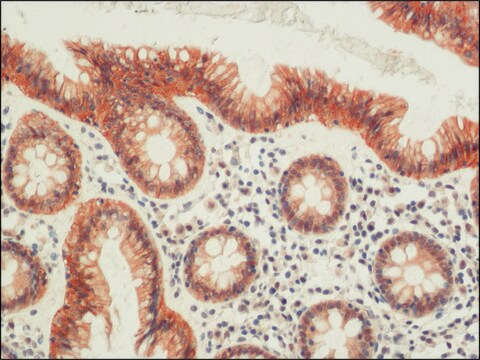추천 제품
생물학적 소스
rabbit
결합
unconjugated
항체 형태
affinity isolated antibody
항체 생산 유형
primary antibodies
클론
polyclonal
형태
buffered aqueous solution
분자량
antigen ~65 kDa
종 반응성
human, dog
농도
~1.0 mg/mL
기술
immunohistochemistry: 10-20 μg/mL using formalin-fixed, paraffin-embedded human colon.
indirect immunofluorescence: 1-2 μg/mL using MDCK cells
western blot: 1.5-3.0 μg/mL using extracts of Caco-2 cells
UniProt 수납 번호
배송 상태
dry ice
저장 온도
−20°C
타겟 번역 후 변형
unmodified
유전자 정보
human ... OCLN(100506658)
일반 설명
Occludin (OCLN) is an integral membrane protein, encoded by the gene mapped to human chromosome 5q13.2. OCLN has a molecular weight of about 65kDa. It possesses four transmembrane domains including a long COOH-terminal cytoplasmic domain, a short NH2-terminal cytoplasmic domain, two extracellular loops and one intracellular turn. It is specifically localized at tight junctions (TJ).
면역원
a synthetic peptide corresponding to a sequence at the C-terminal region of human occludin, conjugated to KLH. The corresponding sequence is highly conserved in rat (89% sequence identity) and in mouse (84% sequence identity) occludin.
애플리케이션
Anti-Occludin (C-terminal) antibody produced in rabbit has been used in immunohistochemistry.
생화학적/생리학적 작용
Occludin (OCLN), along with tight junction (TJ)-associated peripheral membrane proteins plays a vital role in the formation and regulation of TJ. The encoded protein facilitates the translocation of p85a (regulatory subunit of phosphoinositide 3-kinase) to TJs to regulate actin organization after oxidative stress. OCLN is also implicated in cell migration. Mutation in the gene leads to the development of band-like calcification with simplified gyration and polymicrogyria (BLC-PMG).
물리적 형태
Solution in 0.01 M phosphate buffered saline, pH 7.4, containing 15 mM sodium azide.
면책조항
Unless otherwise stated in our catalog or other company documentation accompanying the product(s), our products are intended for research use only and are not to be used for any other purpose, which includes but is not limited to, unauthorized commercial uses, in vitro diagnostic uses, ex vivo or in vivo therapeutic uses or any type of consumption or application to humans or animals.
Not finding the right product?
Try our 제품 선택기 도구.
Storage Class Code
10 - Combustible liquids
WGK
WGK 2
Flash Point (°F)
Not applicable
Flash Point (°C)
Not applicable
시험 성적서(COA)
제품의 로트/배치 번호를 입력하여 시험 성적서(COA)을 검색하십시오. 로트 및 배치 번호는 제품 라벨에 있는 ‘로트’ 또는 ‘배치’라는 용어 뒤에서 찾을 수 있습니다.
Claudin-1 and -2: Novel Integral Membrane Proteins Localizing at Tight Junctions with No Sequence Similarity to Occludin
The Journal of Cell Biology, 141(7) (1998)
Recessive Mutations in the Gene Encoding the Tight Junction Protein Occludin Cause Band-like Calcification with Simplified Gyration and Polymicrogyria
Mary C, et al.
American Journal of Human Genetics (2010)
Complex Phenotype of Mice Lacking Occludin, a Component of Tight Junction Strands
Complex Phenotype of Mice Lacking Occludin, a Component of Tight Junction Strands
Complex Phenotype of Mice Lacking Occludin, a Component of Tight Junction Strands
Mitinouri Saitou, et al
Molecular Biology of the Cell (2017)
Wanghui Jing et al.
American journal of translational research, 10(7), 2137-2147 (2018-08-11)
Chronic kidney disease (CKD) results in various central nervous systems (CNS) disorders including cognitive dysfunction, depression, anxiety, movement disorders, seizures and encephalopathy. Uremic retention products, oxidative stress, inflammation and impaired blood-brain barrier have been implicated as the major mediators of
The Tight Junction Protein, Occludin, Regulates the Directional Migration of Epithelial Cells
Dan Du, et al.
Developmental Cell (2010)
자사의 과학자팀은 생명 과학, 재료 과학, 화학 합성, 크로마토그래피, 분석 및 기타 많은 영역을 포함한 모든 과학 분야에 경험이 있습니다..
고객지원팀으로 연락바랍니다.








